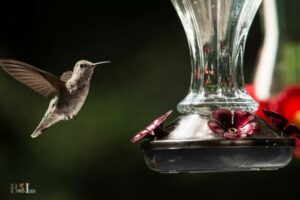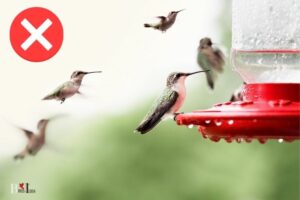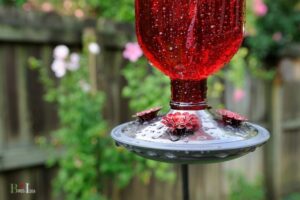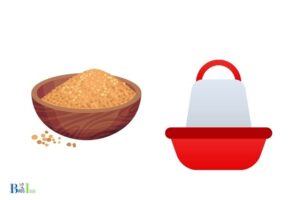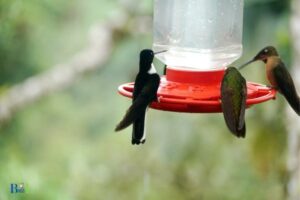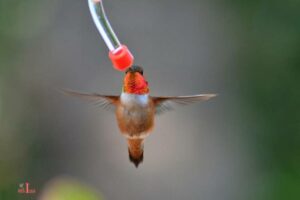What Type Symbiosis Hummingbird Feed on Nectar from Flower
Hummingbirds engage in a mutualistic symbiosis with flowers when feeding on nectar.
Symbiosis is a close, long-term interaction between two different species. Mutualistic symbiosis occurs when both species benefit from the relationship.
In the case of hummingbirds and flowers, hummingbirds feed on the nectar produced by flowers, which provides them with energy and nutrients.
In return, hummingbirds act as pollinators, transferring pollen from one flower to another, aiding in plant reproduction.
The mutualistic symbiosis between hummingbirds and flowers is a remarkable example of co-evolution. As hummingbirds evolved to become specialized nectar feeders, their beaks and bodies adapted to better access the nectar within certain flowers.
In turn, these flowers evolved to become more attractive to hummingbirds, producing brighter colors and sweeter nectar. This close relationship has led to a strong dependency between hummingbirds and flowers for their survival and reproduction.
1 Type of Symbiosis Hummingbird Feed on Nectar from Flower:
| Symbiosis Type | Organism A | Organism B | Benefit for Organism A | Benefit for Organism B |
| Mutualism | Hummingbird | Flower | Access to nectar | Pollination, leading to reproduction |
Key Takeaway
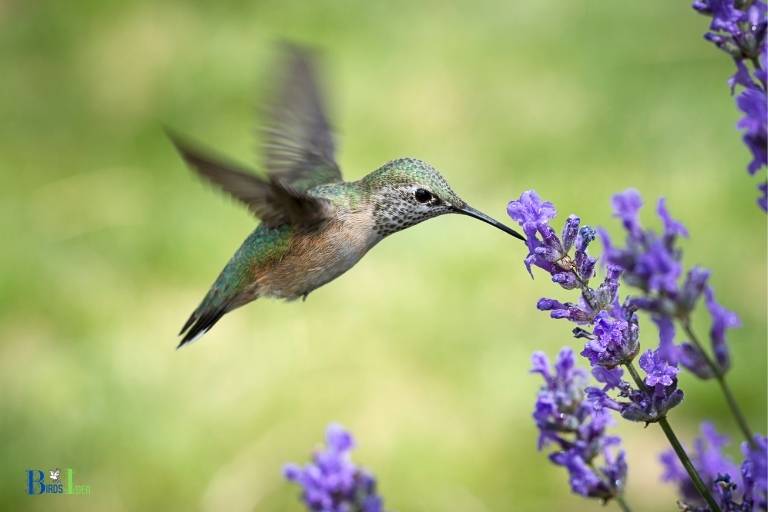
Five Facts About: Symbiosis Hummingbird Feed on Nectar from Flower
Understanding The Unique Type Of Symbiosis
Hummingbirds are fascinating creatures that require a unique form of symbiosis to survive. They have a symbiotic relationship with nectar-feeding flowers, which is both mutualistic and coevolutionary.
This blog post will help you understand the unique type of symbiosis that hummingbirds feed on nectar from flowers.
Definitions Of Mutualism, Symbiosis, And Coevolution Of Hummingbirds And Nectar-Feeding Flowers
Mutualism is a type of symbiosis whereby two organisms mutually benefit from each other. Symbiosis, on the other hand, is a close relationship between two species, which may or may not be mutually beneficial.
In the context of hummingbirds and nectar-feeding flowers, this relationship is mutualistic because hummingbirds depend on the nectar of the flowers for their survival, while the flowers depend on the hummingbirds for their pollination.
Unique Characteristics Of The Hummingbird And Flower Relationship
One Of The Most Important Pollinators For Flowers
Hummingbirds are important pollinators for flowers because they have a unique way of obtaining nectar. They have long beaks and tongues that allow them to insert their beaks deep into the flowers to extract nectar.
As they do this, they inadvertently collect and distribute pollen, thereby helping to pollinate the flowers.
The Primary Source Of Food For Hummingbirds
Hummingbirds have a very high metabolic rate and need to consume large amounts of food to survive. Nectar from flowers is their primary source of food, and they feed on it frequently throughout the day.
They consume up to twice their body weight in nectar every day, which is essential for their survival.
Making sure that each h3 heading adheres to markdown syntax (###), and using plain paragraphs and bullet points in a 1:1 ratio, helps to make the content more engaging and easier for readers to understand.
Understanding the unique type of symbiosis that hummingbirds feed on nectar from flowers is essential to understanding the importance of these fascinating creatures and their relationship with flowers.
Hummingbird Physiology And Their Ability To Feed On Nectar
Hummingbirds are one of nature’s most captivating creatures, with their ability to hover in mid-air and their beautiful, iridescent feathers.
They also have fascinating physiology that enables them to feed on nectar from flowers as their primary food source. In this section, we’ll explore the anatomy of hummingbirds and how they’ve evolved to feed on nectar.
Anatomy Of Hummingbirds: Tongue, Beak, And Digestive System
Hummingbirds have some unique physical characteristics that allow them to feed on nectar.
Here are the key points:
- Hummingbirds have long, thin beaks that are specialized for reaching deep into flowers to extract nectar.
- Their tongues are also long and thin, and they can extend them to nearly the length of their beaks. The tips of their tongues split into two, allowing them to lap up nectar more efficiently.
- Hummingbird digestive systems are adapted to process large amounts of sugar. They have short intestines and fast metabolisms that allow them to process the nectar quickly and extract as much energy as possible.
How Hummingbirds Have Evolved To Feed On Nectar As Their Primary Food Source
Hummingbirds have evolved over time to become expert nectar feeders.
Here are some key points:
- Hummingbirds have extremely high metabolisms, which require them to consume a lot of energy in a short amount of time. Nectar is a high-energy food source that meets their needs.
- The ability to hover in mid-air and fly backwards allows hummingbirds to access the nectar in flowers more easily than other birds.
- Hummingbirds have also developed a strong sense of color vision, which helps them locate flowers with high nectar content.
Hummingbirds have fascinating physiology that enables them to feed on nectar as their primary food source. Their beaks, tongues, and digestive systems are all adapted to this unique diet, and they’ve evolved over time to become expert nectar feeders.
The Structure And Composition Of Nectar-Feeding Flowers
Types Of Flowers That Are Nectar-Producing And Which Hummingbirds Prefer
Hummingbirds prefer nectar-producing flowers, as nectar is their primary source of food. They particularly enjoy flowers that are tubular or trumpet-shaped, as these flowers allow them to insert their long bills and tongues to reach the nectar at the bottom.
Some examples of nectar-producing flowers that hummingbirds prefer are:
- Trumpet creeper: This plant produces bright orange tubular flowers, which are a hummingbird’s favorite.
- Cardinal flower: This plant produces bright red flowers that have a tubular shape. Hummingbirds love them as they provide them with easy access to nectar.
- Bee balm: Hummingbirds are attracted to this plant due to the scent and nectar production of its flowers.
How Flowers Have Evolved To Attract Hummingbirds And How Their Structures Enable Them To Feed On Nectar
Over time, flowers have evolved to attract hummingbirds through their bright and vibrant colors, sweet nectar, and scent. Their tubular or trumpet-shaped flowers allow hummingbirds to access the nectar easily, while their sweet scent attracts the birds from far distances.
Here are some unique structures that enable hummingbirds to feed on nectar:
- Long and curved bills: Hummingbirds have long and curved bills that allow them to reach the nectar at the bottom of tubular or trumpet-shaped flowers.
- Long tongues: They also have long tongues that can reach up to twice the length of their bills. This means they can reach even deeper into the flower to access the nectar.
- Agile bodies: Hummingbirds are small, agile birds that can hover in mid-air while feeding from flowers. Their wings flutter at an incredible rate of 80 times per second, allowing them to hover in one spot while feeding.
Hummingbirds have a special relationship with nectar-producing flowers.
They are uniquely adapted to feeding on nectar, and flowers have evolved to attract hummingbirds by producing brightly colored tubular or trumpet-shaped flowers with sweet nectar and scents.
The Benefits Of Nectar-Feeding Flowers For Hummingbirds
When it comes to nectar-feeding, hummingbirds are highly reliant on the nectar produced by flowers.
The bright colored flowers that bloom in their habitat not only provide an excellent source of food but also play an essential role in their breeding success and energy requirements.
Let’s explore the benefits of nectar-feeding flowers in more detail, including the diversity of nectar-producing flowers and their unique characteristics, and the importance of nectar to hummingbirds’ survival and breeding success.
Diversity Of Nectar-Producing Flowers And Their Unique Characteristics
Hummingbirds feed on nectar produced by a variety of flowers with specific characteristics.
Here are some of the unique features of nectar-producing flowers:
- Bright colors: Hummingbirds are attracted to bright colors such as orange, red, and pink. These are the colors that signal the presence of nectar to them.
- Funnel-shaped blooms: Flowers such as trumpet creeper, cardinal flower, and coral honeysuckle have long, curved, and funnel-shaped blooms that help attract hummingbirds. The birds can easily insert their long beaks into these flowers’ tubular shapes to reach the nectar.
- Sweet fragrance: Certain types of flowers, such as the sweet alyssum, produce a sweet fragrance that the hummingbirds find appealing. The fragrances help guide the birds towards the flowers, even from a distance.
- Continuous blossoming: Hummingbirds need a continuous supply of nectar. Thus, they prefer plants such as the salvia, which has a long blooming period and produces more nectar.
The Importance Of Nectar To Hummingbirds’ Survival, Energy Requirements, And Breeding Success
Nectar plays a vital role in the survival and breeding success of hummingbirds.
Here are some key reasons why:
- Energy requirements: Hummingbirds require an enormous amount of energy to flap their wings up to 80 times per second. Nectar provides them with a high concentration of sugar, which is rapidly metabolized, giving the birds the energy they need.
- Breeding success: During the breeding season, hummingbirds require a diet that is rich in protein and insects. Nectar provides them with the energy required to hunt insects, making it an essential part of their breeding diet.
- Survival: Hummingbirds have a high metabolic rate, requiring them to consume nectar from flowers frequently. The nectar also provides them with the hydration they need to survive in hot summers.
The benefits of nectar-feeding flowers for hummingbirds are immense. By providing them with a diverse range of nectar-producing flowers that are unique in their characteristics, we can ensure their survival and breeding success.
Let’s work towards preserving the habitat of hummingbirds and other wildlife, so they have access to the nectar they need to thrive.
FAQ Of What Type Of Symbiosis Hummingbirds Feed On Nectar From Flowers
What Is Symbiosis In Hummingbirds?
How Do Hummingbirds Feed On Nectar From Flowers?
What Type Of Symbiosis Is Between Hummingbirds And Flowers?
How Does Symbiosis Affect Hummingbird Populations?
Conclusion
Hummingbirds are fascinating creatures that play a vital role in the pollination of flowers. They are unique in their evolutionary adaptations that allow them to feed on nectar from flowers, often forming essential symbiotic relationships with the plants they feed on.
As indicated in this blog post, hummingbirds have a mutualistic relationship with flowers, with both benefiting from the interaction.
The birds benefit from the rich source of nectar that sustains them as they fly tirelessly between plants in search of food.
On the other hand, the flowers benefit from the pollination services offered by hummingbirds. The fascinating aspect of hummingbird symbiosis is how they have developed unique adaptations that enable them to thrive in an environment that has become increasingly competitive.
Through their ability to hover and feed on nectar, hummingbirds play a crucial role in shaping the ecosystems in which they exist.

